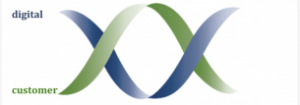Caz and I are digital transformation consultants. We have had lots of experience at NixonMcinnes, of writing strategies and helping organisations to develop new mindsets for the 21st century. We have worked hard internally in organisations to help them adjust to the challenges of a disrupted, digital marketplace.
What we noticed was that no one really seemed (seems?) to have a handle on what digital transformation entailed, and for many it just meant doing the same stuff as always but on mobile, cloud or tablet.
That didn’t satisfy us. It didn’t feel like the whole story. It didn’t feel like it was making enough of a difference and having enough of a tangible impact on customers.
You see, we love helping customers, and we saw the rise of digital servicing as a driver for organisations to improve their customer relations to meet the needs of the digitally engaged 21st Century citizen. It wasn’t long before we started to focus our offering in this way and we shifted to being a digital customer engagement consultancy.
Guess what? This isn’t the whole story either.
Whilst it is true that you can’t digitally transform unless you embrace the customer; engage, listen and respond to them, and change the way your organisation views and values them in a wholesale way, It is also true that you can’t be truly and effectively customer-centric in today’s world unless you adopt a digital mindset.
This is the part that we had been missing and I think it is the part that most digital transformation and customer programs miss.
And it’s not just about technology and creating new services for your customers in digital channels. Todays world is characterised by volatility, uncertainty, change and ambiguity (VUCA). If you are going to withstand the threat of being disrupted in your market you need to make sure that it runs much deeper.
To be truly fit for the 21st century, organisations need customer and digital in their DNA entwined and working together, internally and externally, to create truly transformative results.

This is both a cultural shift and an operational shift. [Photo credit: Stuart Caie]
It means creating a new commitment to the customer within the organisation and evincing new behaviours (agility, transparency, empowerment, etc) that allow you to leverage the benefits that digital brings, to ensure that that commitment is delivered against in the right way.
It means designing the right L&D services, and having the right tools, processes and ways of working to ensure that the right people can collaborate and share insight and create new ways to doing business.
The problem is that this is big stuff. Quite frankly, change on this level difficult to achieve, and the larger your organisation the harder it becomes (and probably, the more you need it).
I believe it is because of the way business is set up the old management paradigm that divides responsibility and sets divisional targets. This creates a situation of internal competition for resources and a lack of alignment around desired outcomes for different teams.
Consider how we talk about the customer. In sales we talk about the funnel, in marketing it might be awareness and in service we talk about resolutions. We literally have a different language.
We are also typically hierarchical in our organisations. Leadership is not devolved and the exec is often isolated from the customer. In fact those that actually talk to the customer are usually the most disenfranchised and least valued staff, with little power or business influence.
In this environment, there is no throughflow in the organisation. No DNA other than the next set of accounts and no opportunity to become a customer-focused, digitally enabled, agile player.
Sure you might get pockets of innovation but the chances are you are largely reactive and most of your staff and even exec feel powerless to make a real change to the way the business operates.
So how you break out of this?
In short: Customer Hubs.
Customer Hubs are a project that we are working on in partnership with author and customer guru, Martin Hill-Wilson and systems, and experience designer, Ben Smithwell.
A Customer Hub is, in its simplest terms, a space in an organisation that provides a real time view of customers and customer engagement. Representatives from across the business are seconded to the hub and during their tenure in the hub they share their insight and experience with each other. This creates a different perspective on their day-to-day activity but also allows them to work together to deliver longer-term, trickier change projects, directly directed to improving the customer experience they see. The representatives also act as champions for the hub and share their experience and ethos with their departments.
At the end of their tenure they mentor a new representative into the hub to the journey can continue.
Representatives can be from any department in the business, e.g. sales, service, marketing, comms, product, digital, innovation, HR, etc, depending on your immediate priorities but as the hub cohorts change over time, eventually the entire business is exposed to this new way of working.
- The hub is non-hierarchical, empowered and agile.
- It has a start-up mentality.
- It is committed to the customer and digitally enabled.
- It is self-sustaining.
- It has a shared set of outcomes.
- It is transformative.
- And it is the customer and digital DNA of your organisation.
So, if you are struggling with digital transformation in your organisation and you’d like to chat more about Customer Hubs and how you could set one up in your business, why not drop us a line, we’d love to share our ideas.

